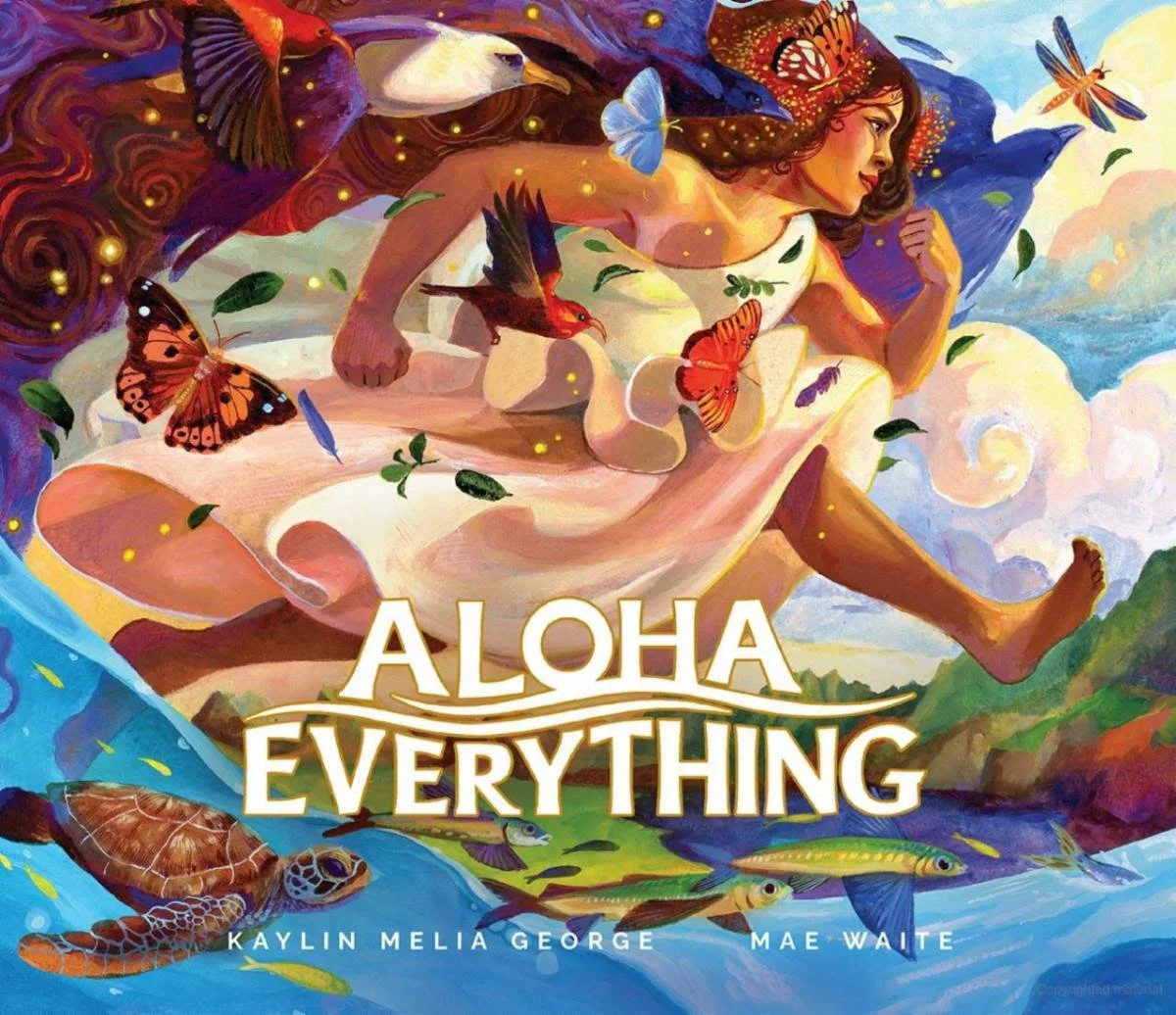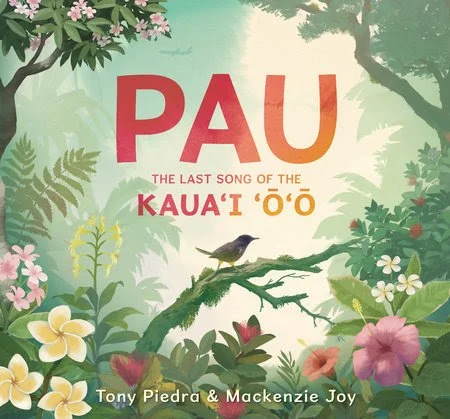Hawai‘i, Lost and Found
Reviewed by Jerry D. Flack, Ph. D.
Piedra, Tony & Mackenzie Joy. PAU: The Last Song of the Kaua‘i ‘O ‘O. Somerville, MA: Candlewick Press, 2024.
George, Kaylin Melia. Aloha Everything. Illus. by Mae Waite. Brooklyn: Red Comet Press, 2024. Winner of the Asian/Pacific American Library Association award, 2025. Winner of the Hawai‘i Keiki Book Award, 2025.
Two new exemplary picture books set in Hawai‘i are devoted to the opposite themes of loss (the extinction of songbirds) and discovery (the aloha spirit). Both will appeal to gifted readers of all ages.
In the Hawaiian language, the word pau means “the end.” In a hauntingly beautiful lament, the talented team of Tony Piedra and Mackenzie Joy use the tragic extinction of one forest songbird, the Kaua‘i ‘O ‘O, to explore the causes of the mass extinction of plant and animal life on Kaua‘i and the other islands of the Hawaiian archipelago. The elegy of the life and loss of the Kaua‘i ‘O ‘O is a verbal and visual presentation that begins five million years ago when Kaua‘i was born from volcanic action. Over great expanses of time, plants and animals populated the island. One species to develop was the ‘O ‘O. Their lovely song greatly enriched the island for thousands of years.
The first humans to inhabit Kaua‘i arrived dating from 400 to 1,000 CE. The Polynesians introduced new plants and animals. Their coastal villages and gardens forced the ‘O ‘O to flee from the coastal gardens to the island’s then-great forests. Their beautiful songs continued, but in ever diminishing numbers. Across the centuries, more people inhabited the island. Europeans discovered it in 1778 CE. These explorers and settlers introduced more people and more non-native species such as black rats, cats, and mosquitoes. The influx of Europeans also meant more loss of habitat for native species. In the 1960s, bird lovers and scientists tried to find a way to save the ‘O ‘O bird from extinction. Natural disasters such as Hurricane Iwa in November, 1982, damaged and destroyed even more habitat of forest songbirds. By 1987, the sweet song of the Kaua‘i ‘O ‘O bird had disappeared forever.
Substantial end notes make readers aware of the continued decimation of native birds and other species in Hawai‘i. A colorful and informative timeline begins with the creation of Kaua‘i more than five million years ago and continues to the present day. It notes the events that brought about the tragic extinction of many species of birds whose songs will never be heard again. The gorgeous digital artwork chronicles the life and extinction (PAU) of the ‘O ‘O bird in both the primary narrative and in the enlightening back matter. The end pages dramatically show the tragic loss of native species that can only be seen and heard by today’s children in museums.
Aloha Everything is one of the most highly honored children’s books in 2025. Poet Kaylin Melia George uses rhyming quatrains to reveal the wonders of Hawai‘i, her native state. She narrates a story of the geology, history, flora and fauna, and indigenous people of America’s most beautiful state. She reveals much about Hawai‘i beginning with the birth of an indigenous baby girl who grows up in the incomparable islands that make up America’s 50th state.
In the hush of the night
with the moon still aglow,
a small baby was born
where the koa trees grow.
George’s narration and Mae Waite’s magnificent hand-painted collages also accentuate the history of the hula, a storytelling choreography unique to the first humans to inhabit Hawai‘i.
The verse narration and the extraordinary paintings introduce and accentuate the geological history of the islands and the development and settlement of the Polynesian navigators who first discovered Hawai‘i. The subtext of the hula brings forth the astounding beauty of Hawai‘i genealogy, nature, and stewardship given by the first inhabitants of the islands.
Crucial back matter includes a glossary of 25 Hawaiian words used in the narrative verses plus a pronunciation guide of the rich and melodic Hawaiian language. Aina translates as land and earth while wahine is the island word for woman.
The brilliant combination of narration and Technicolor-like illustrations is authentic. Kaylin Melia George grew up on the island of Moloka‘i. At bedtime she listened to epic bedtime stories shared with her by her Native Hawaiian mother. Illustrator Mae Waite was born in China, but was adopted by island parents and raised in Hawai‘i from the age of three years.
Home and School Activities
The Hula. Encourage gifted researchers to explore the hula on YouTube. Seek both male and female versions of the hula. It is a misconception that the hula is performed only by females. In ancient Hawai‘i the hula was performed first by males at indigenous ceremonies. The best male dancers became warriors. Encourage young people to attempt to learn the early or fundamental choreography. Aloha Everything makes it very clear that the hula is rich in history and tradition. It is not a storytelling dance that can be mastered without a great deal of instruction, learning, and training or practice. Can students find a film that provides elementary instruction in performing the hula? Encourage students to use their psychomotor talents to attempt to learn and perform basic hula steps.
My State. Aloha Everything implies that Hawai‘i may well be the most beautiful state in the U.S.A. What state do young readers believe to be the most beautiful state in America? Urge readers to imagine that the state department of tourism has commissioned them to create a travel guide that promotes the exquisite beauty of their home state. Creative students can use any media (e.g., collage, colored felt pens). Their creative travel guides should feature at least ten state highlights and maps. Other projects might include the creation of a state travel poster that glorifies the natural wonders of their state or a set of equally inviting post cards. The creation of a souvenir to represent their most beautiful state is still another option.
Understanding a Word. The word aloha is rich in connotation. It is a word with a multiplicity of meanings and uses. Encourage readers to choose another word such as aloha that is rich in its multiple levels of meaning. Such sample words might include beauty, faith, love, talent, pride, and equality. Once students have chosen a favorite word, their exploration of a single word begins. Ask them to write their own definition of the word they choose to explore. Next, direct young researchers to find pictures, words, and other artifacts that visually represent their chosen word. They can use such materials to create a collage or other visual depictions of their special word. This activity may be followed by words that convey a personal experience with the key word choice. Such a story should illustrate one of many possible meanings of the word. Ask researchers to find synonyms of their word. Using their original artwork, encourage creative scholars to compile all the findings into their own version of a picture book similar to Aloha Everything. Perhaps a title for their compilation might be titled, “Beauty Everywhere.”
What Can I Do? The Kaua‘i ‘O ‘O is gone forever. Other songbirds in the island are greatly threatened. Ask young readers what they can do to save endangered plants and animals in Hawai‘i and all over the world. A great place to begin is by reading Forest Olson’s “Climate News” columns in the present and past newsletters of Gifted Development Center. Young researchers can explore further online sources to read about the action plans to save the environment proposed by other young people. Many of today’s readers may never visit the islands of Hawai‘i, but there are still endangered species of plants and animals closer to home. Encourage gifted youths to champion the causes of conservation and preservation of the wonders of the natural world. What can they do to prevent the extinction of endangered plants and animals? What is their action plan?


